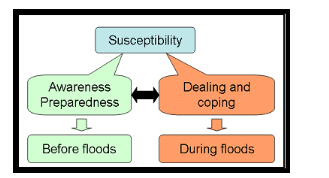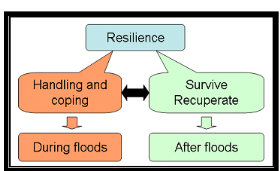2.2. Flood Vulnerability
Factors
The vulnerability of any system (at any scale) is a function of
the exposure and susceptibility of that system to hazardous conditions and the
ability, capacity or resilience of the system to cope, adapt and/or recover
from the effects of those conditions (Smit and Wandel, 2006). Core factors of
vulnerability encompass exposure, susceptibility or sensitivity and resilience
or coping and adaptive capacities. Exposure generally refers to the extent to
which a unit or a system of the assessment (community, city, building) falls
within the geographical range of a hazard event (Birkman, 2013, p 25).
According to IPCC (2012a, p 559), exposure describes the
presence of people, livelihoods, environmental services, resources and
infrastructures or other valuable items in place that could be affected.
Exposure to floods could be understood, then, as the presence of valuable items
of human-environment, or socio-ecological systems that are present in
floods-prone areas. The indicators for this component can be put in two
categories; the first one covers the exposure of different elements at risk and
the second one gives details on the general characteristics of the flood. While
the first category of indicators supplies information about the location,
elevation, population density, land-use, their proximity to the river, their
closeness to inundation areas, the second category provides information about
the frequency of floods in floodplains, their duration and magnitude (Balica,
2007, p 31).
Penning-Rowsell and Chatterton (1977) defines susceptibility as
the relative damageability of property and materials during floods or other
hazardous events. According to Turner et al. (2003), susceptibility is mainly
defined by cross-scale interactions of multiple internal stresses and
perturbations. The concept of susceptibility or sensitivity is the
vulnerability factor that describes the human-environmental or socio-ecological
conditions or current state that can worsen the hazard, or trigger an impact.
So, flood susceptibility indicators evaluate the sensitivity of an element at
risk before and during a flood event
"figure 3" .

Figure 2 Susceptibility
framework
Source: Balica (2007, p 33)
Buckle (1998) defines resilience as "the capacity that people or
groups may possess to withstand or recover from emergencies and which can stand
as a counterbalance to vulnerability". According to UN/ISDR (2004), resilience
is determined by the degree to which the social system is capable of organizing
itself to increase its capacity for learning from past disasters for better
future protection and to improve risk reduction measures.
For Turner et al (2003), resilience of the system is often
evaluated in terms of the amount of change a given system can undergo and still
remain within the set of natural or desirable states.
Based on the above definitions, flood resilience can be seen as
the ability of a system or a community to mitigate or minimize threats of
floods on itself. Resilience of a system to flood disasters can only be
considered with past flood events as it focuses on elements encountered during
and after the floods "figure 4"

Figure 3 Resilience
framework
Source: Balica (2007, p 35)
| 


